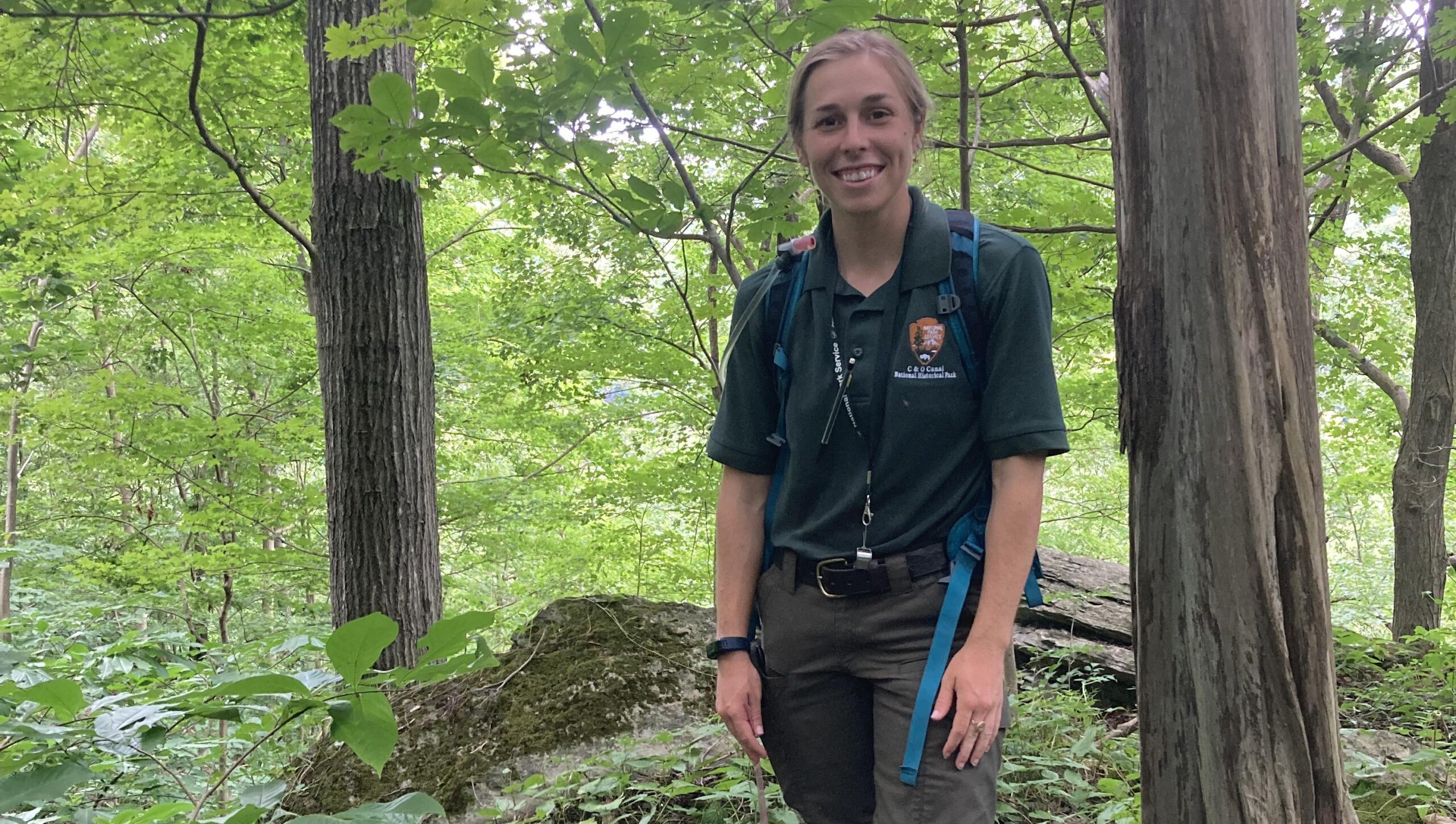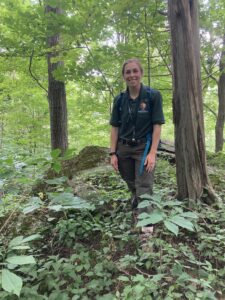
Celebrate your love for the C&O Canal by sharing your personal story about the Park. Each story will take a look at a person’s relationship with the C&O Canal. Whether an NPS ranger, a volunteer, or a visitor, everyone has a story to tell about the canal! If you want to share your story, fill out the form below, email it to us at [email protected] or post it on your social media feeds with the hashtag #MyCanalStory. We could use your story here on our website!
Sarah Brown, Biological Technician at the C&O Canal National Historical Park
C&O Canal Trust: How did you hear about the C&O Canal?
Sarah: I had first heard of the C&O Canal through two good friends I met while attending James Madison University for graduate school. They rode the full Canal one summer and came back telling me all the great things about their trip and about the Park. Since I am not from the area, I was very surprised to learn there exists this long national park that follows the Potomac River and is ideal for walking and biking. However, I was living in Virginia at the time and was not very near the Park. So, I just knew the C&O Canal existed, but it had not taken shape as a place to visit let alone to work. The C&O Canal finally took shape when I worked with the USGS last summer on a project monitoring bees and flowers among several national parks including the C&O Canal. During that summer, I would travel to sites within the Park for work and would bike the towpath as much as I could in my free time!
 C&O Canal Trust: Tell us about your professional background.
C&O Canal Trust: Tell us about your professional background.
Sarah: I am fairly early in my, hopefully, long career in plant monitoring, ecological restoration, and natural resource management. Prior to joining the Park, I primarily worked field technician positions, but the projects and locations of these positions have varied. One project was exploring the use of native plants in sustainable and water efficient landscaping in Texas. Another project was in south-eastern Ohio on former surface coal mine land where we were restoring the forest understory with native plantings and invasive species removal. For another project I was based in Virginia and traveled to West Virginia to monitor pollinators visiting flowers present in a steep-sloping, dry, shale substrate environment known as a shale barren. The USGS project last summer was my most recent work before joining the C&O Canal.
C&O Canal Trust: What is your position with the C&O Canal NHP, and what does the job entail?
Sarah: My position title is biological science technician, which can be a catch-all position for managing and executing natural resource management projects with the Park. This mean I spend much of my time out in the park completing vegetation surveys, recording any rare plant occurrences, and fulfilling the field work necessary for any additional research or monitoring projects occurring in the Park. However, my most important focus is leading the Park’s Rare Plant Propagation project. The goal of the project is to harvest seed material from wild populations in the Park, grow the material, and plant grown material back into the Park. This means that most of my time is spent monitoring documented rare plant populations for their flower and fruit production, collecting seeds, and preparing collected material to be grown by our greenhouse partner.
C&O Canal Trust: Can you talk about the Rare Plants Initiative with the Park?
Sarah: Thanks to the C&O Canal’s proximity to the Potomac River, the Park protects a large stretch of unfragmented, unique, and highly biodiverse riparian forested and open habitats. Included in this biodiversity are a recorded 200 state rare, threatened, and endangered plant species. The Park has a long history of rare plant surveying, with the earliest rare plant occurrence recorded in 1870, and the Park’s Rare Plants Initiative is a continuation of such surveying. The core of the Park’s Rare Plants Initiative is monitoring known occurrences for a population’s persistence in that location, recording any changes in the population, and document threats such as invasive species encroachment or excessive deer browse. Locating new occurrences is certainly included in the initiative, but monitoring is such a high priority because frequently these plants exist in very precarious circumstances and/or in very low numbers so that plants you saw five years ago might not be present today. Thus, our monitoring of known occurrences will go forward to inform us of some of the most threatened plants in the park and any management actions to protect such species. The Park’s newest management action to protect rare plants is the Rare Plant Propagation project. One method of protecting known populations of rare plants is to supplement those populations with more individuals. Thus, the Park’s Rare Plant Propagation project intends to supplement populations by partnering with the Mt. Cuba Center to grow seeds harvested from populations in the park. We are in the first year of the project, so only seed collection has occurred so far. Next year will be our first year of planting material back into the Park, and we’re all eager so see how populations respond to the supplementation.
C&O Canal Trust: Do you have a favorite rare plant?
Sarah: Polygala polygama also known as racemed milkwort! It is such an adorable little plant that grows about 6 to 12 inches tall. The plant produces these tiny delicate but bright pink flowers and has incredibly hairy seeds that look almost like animal fur under a microscope. Keep your eyes open for it between May and July in dry rocky or sandy woodlands and clearings!
C&O Canal Trust: When you visit the park recreationally, what do you like to do?
Sarah: This may seem so simple, but I enjoy walking the towpath listening to music, a podcast, or audio book. It’s nice to be away from vehicle traffic and just have space to walk as far as I want.
C&O Canal Trust: Do you have a favorite section of the park?
Sarah: My favorite section of the park has got to be the area around Paw Paw or Bonds Landing. In general, I deeply enjoy the western part of the park because of its scenery, the mountains, and seclusion. Plus, I can find my favorite ecosystem in that part of the park: shale barrens!
C&O Canal Trust: What have you liked most about working with the C&O Canal?
Sarah: The work environment all around is excellent. I get to work with great people and spend most of my days outside in a beautiful place!





